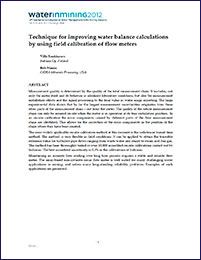2012 Water in Mining
Technique for Improving Water Balance Calculations by Using Field Calibration of Flow Meters
Measurement quality is determined by the quality of the total measurement chain. It includes, not only the meter itself and its behavior in idealized laboratory conditions, but also the measurement installation effects and the signal processing to the final value in water usage reporting. The large experimental data shows that by far the largest measurement uncertainties originates from these other parts of the measurement chain – not from the meter. The quality of the whole measurement chain can only be assured on-site when the meter is in operation at its true installation position. In an on-site calibration the error components caused by different parts of the flow measurement chain are identified. This allows for the correction of the error components in the position of the chain where they have been created.
The most widely applicable on-site calibration method at this moment is the radiotracer transit time method. The method is very flexible in field conditions. It can be applied to obtain the traceable reference value for turbulent pipe flows ranging from waste water and slurry to steam and flue gas. The method has been thoroughly tested in over 10,000 accredited on-site calibrations carried out by Indmeas. The best accredited uncertainty is 0.5% in the calibrations of Indmeas.
Maintaining an accurate flow reading over long time periods requires a stable and reliable flow meter. The array-based non-invasive sonar flow meter is well suited for many challenging water applications in mining, and solves many long-standing reliability problems. Examples of such applications are presented.

